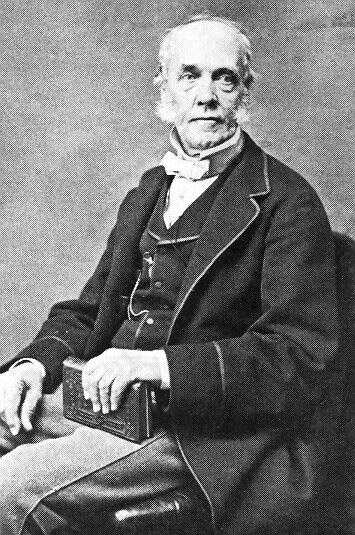<Back to Index>
- Astronomer William Lassell, 1799
- Novelist Ivan Alexandrovich Goncharov, 1812
- Prime Minister of Bulgaria Georgi Dimitrov Mikhaylov, 1882
PAGE SPONSOR

William Lassell FRS (18 June 1799 – 5 October 1880) was an English merchant and astronomer.
Born in Bolton and educated in Rochdale after the death of his father, he was apprenticed from 1814 to 1821 to a merchant in Liverpool. He then made his fortune as a beer brewer, which enabled him to indulge his interest in astronomy. He built an observatory at Starfield near Liverpool with a 24-inch (610 mm) reflector telescope, for which he pioneered the use of an equatorial mount for easy tracking of objects as the earth rotates. He ground and polished the mirror himself, using equipment he constructed. The observatory was later (1854) moved further out of Liverpool to Bradstones.
In 1846 Lassell discovered Triton, the largest moon of Neptune, just 17 days after the discovery of Neptune itself by German astronomer Johann Gottfried Galle. In 1848 he independently co-discovered Hyperion, a moon of Saturn. In 1851 he discovered Ariel and Umbriel, two new moons of Uranus.
When Queen Victoria visited Liverpool in 1851, Lassell was the only local she specifically requested to meet.
In 1855, he built a 48-inch (1,200 mm) telescope, which he installed in Malta because of the better observing conditions compared to England. On his return to the UK after several years in Malta he moved to Maidenhead and operated his 2-foot telescope in an observatory there.
He won the Gold Medal of the Royal Astronomical Society in 1849, and served as its president for two years starting in 1870. He was also elected a Fellow of the Royal Society in 1849 and won their Royal Medal in 1858.
Lassell died in Maidenhead in 1880. Upon his death, he left a fortune of £80,000 (equivalent to millions of American dollars by today's standards). His telescope was presented to the Royal Observatory in Greenwich.
The crater Lassell on the Moon, a crater on Mars and a ring of Neptune are named in his honour.